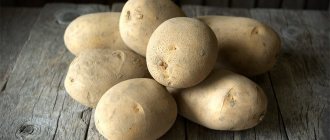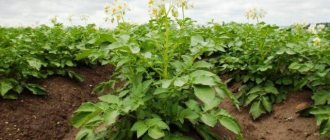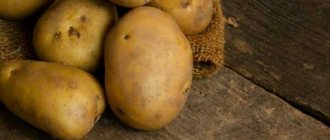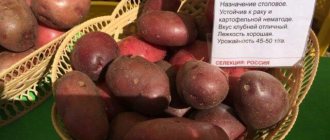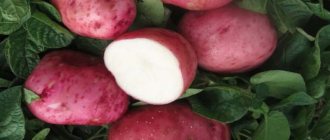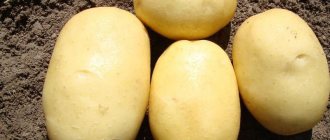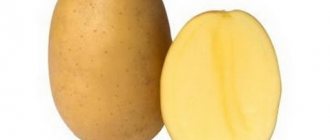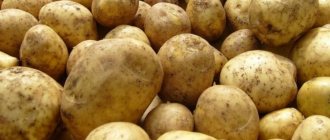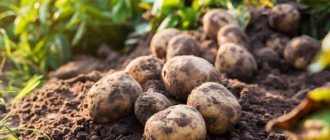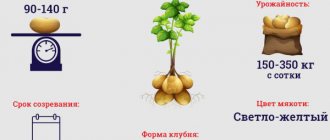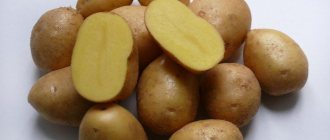Potatoes 'Borodyansky pink'
Latin name: solanum tuberosum 'borodyanskiy rozoviy'
Main genus: Potato
- sandy loam
- loam/clay
- black soil
- open ground
- universal
- slightly acidic (ph 5.5 - 6.5)
- neutral (ph 6.5-7)
- perennial
- central region
- Central Black Earth Region
- Volga-Vyatka region
- Middle Volga region
- East Siberian region
- Far Eastern region
- North-West region
- Not indicated
- Not applicable
- Not indicated
- Not indicated
- Not applicable
- Not indicated
- Not indicated
- slightly spreading/compact
- Not applicable
- medium branched
- Not indicated
Description of the plant:
Potato 'Borodyansky pink' is a variety bred at the Ukrainian Research Institute of Potato Farming. Approved for use in the North-Western, Central, Volga-Vyatka, Central Black Earth, Middle Volga, East Siberian and Far Eastern regions in 1994.
Dimensions and growth form:
The 'Borodyansky pink' variety is represented by erect, low bushes. The stems are numerous, medium-branched, angular in cross-section, and heavily leafy.
The leaf is large, strongly dissected, dark green, medium pubescent, with moderate veining. The leaf lobes are medium-sized, with smooth edges. Stipules are crescent-shaped.
Flowering is average, short-term. The inflorescence is compact, multi-flowered. The peduncle is slightly colored without bracts. The peduncle is short, slightly colored. The calyx is entirely pigmented. Sepals are short, subulate. The corolla is medium-sized with wide lobes and poorly developed tips, red-violet, with white tips on the outside. Berry formation is rare.
Tubers:
Size, shape and color:
The tubers are large, leveled, round in shape, with a blunt apex and a flat stolon trail, pink, weighing 90–140 g. The peel is smooth. The eyes are few and small. The flesh is creamy or yellow and does not darken when cut.
Starch content 14.2–18.6%.
The taste is good to excellent.
Ripening time and yield:
The 'Borodyansky pink' potato is an early ripening variety (early ripening). The yield is high and stable and amounts to 2.5–3.7 kg/m2.
Keeping quality:
The crop has good keeping quality.
Disease resistance:
The variety is resistant to potato blight. Relatively resistant to late blight. It is quite strongly affected by viral diseases and common scab. Susceptible to macrosporiosis, prone to rot during storage.
Directions for use:
Recommended for use for table purposes.
Potato variety Borodyansky. The best potato varieties
Every gardener, when planting potatoes on his plot, would like to get a decent harvest; this can be achieved by planting only the best varieties of potatoes.
Possessing high nutritional value, calorie content and a set of useful amino acids, potatoes have become an indispensable food for humans. Thanks to the great Tsar Peter I, potatoes appeared in Rus' and truly became the second bread. Many gardeners and summer residents make a lot of effort to grow a rich and tasty potato harvest, but the results do not always please them. There are many factors influencing potato yield, but one of the most important is the selection of seed material.
To plant and obtain a good harvest, the best varieties of both domestic and foreign selection are used.
Let's look at the best domestic potato varieties.
Variety Lugovskoy. This is a mid-season, high-yielding table variety. The bush is erect, compact, of medium height, moderately leafy. Stems are angular, slightly branched. The leaves are medium sized, medium lobed, matte, with sharp veining. Inflorescences are multi-flowered. Peduncles are medium, not pigmented. Pedicels are short, weakly pigmented. The flowers are white. Flowering is not abundant and short-lived. Rarely produces berries. The tubers are light pink, oval, with small pink eyes. The peel is smooth. The pulp is white and does not darken when cut. The sprouts are red-violet. The weight of the marketable tuber is 91 - 150 g. The taste is good. The starch content in tubers is increased - 16.1 - 18.4%. Well preserved. It is characterized by high field resistance to late blight, viral diseases and cancer, intensive and early accumulation of yield. Potatoes should be planted no later than April 15–20. The row spacing is 55–65 cm. The distance between tubers in a row is 25–35 cm. During the growing season, the area is weeded, the row spacing is loosened 2–3 times and the bushes are hilled up.
Common varieties of red potatoes
Today, red potato varieties are increasingly gaining popularity among gardeners, thanks to their beautiful fruits and delicate taste. Red potatoes, as well as fruits with white and yellow skins, can be used to make popular French fries, boiled or fried. Large red potatoes come in different varieties and are divided into early, mid-early and late varieties. Many gardeners wonder which potatoes are better, with yellow or red skin?
Common varieties of red potatoes
In fact, each variety has its own advantages; red potatoes with white flesh look brighter in appearance. Also, the variety of varieties of red-skinned potatoes will not leave any gardener indifferent. Gardeners should choose the red potato variety that best suits your climate.
Rodrigo
The Rodrigo variety ripens in 70-85 days and is a mid-late species. Productivity per hundred square meters is 450 kg. Rodrigo is a type of potato with red skin and yellow or white flesh. One fruit can weigh up to 800 grams with proper care. The Rodrigo variety has no disadvantages, as it is suitable for growing in any climate and on any soil. Rodrigo is best purchased by those gardeners who want to get a bountiful harvest at minimal cost, as well as by those who live in the north of Russia.
Advantages
- Smooth fruits with a minimum number of eyes are excellent for mechanical cleaning.
- Rodrigo can be used for boiling, frying and making French fries.
- Externally, dark red tubers look very beautiful.
Red scarlet
Red Scarlet is an early variety of Dutch selection. Grows within 80 days. During flowering, the potato stem is short and has a red-violet tint. Productivity level up to 600 c/ha. Red scarlet is most suitable for the southern part of Russia. One fruit weighs 90 grams. The shape of the tuber is slightly oblong and smooth, the surface is without grooves. The fruit has few eyes.
Advantages
- Tolerance to dry summers.
- No darkening due to damage.
- Popular among farmers.
- Good taste.
- Security level.
- Easy to transport.
- With frequent use for planting, it does not change its original varietal qualities.
Related article: Potato variety “Sarma” - description and photo
The disadvantages include the average level of resistance to popular vegetable diseases, for example, common scab. During tuber germination, potatoes may lose their smoothness.
Potato varieties for mashed potatoes. 40 varieties of potatoes for mashing, frying, baking and French fries
Don't know which potatoes to grow for mashing and which for frying? Each variety has characteristics that correspond to one of the cooking methods. Growing the first variety you come across without knowing its specifics is no longer fashionable and it’s time to switch to conscious potato growing.
What is the difference between boiling potatoes and baking potatoes? Yes, to almost everything: keeping quality, impact resistance, and starchiness. But if you are not an agricultural academic, it will not be easy to figure it out on your own, so we have prepared for you a list of the most popular potato varieties that are most often found in markets and stores in our country, with comments.
Potato varieties for chips and deep frying
There are quite strict requirements for the varieties of French fries. Potatoes should be starchy, withstand shock well and not darken. In addition, it should be stored all winter without losing its taste. Only 2 varieties that are currently on the Russian market meet these conditions.
Anosta
The Dutch variety is resistant to most diseases, has yellow flesh, but, alas, the taste is only suitable for chips and fries - eating it in any other form will not be very pleasant. But its smooth tubers look beautiful and can attract the buyer’s eye.
Lady Claire
Another “chip” variety, the complete opposite of the previous one. It is soft, melts in your mouth, moderately starchy and slightly sweet. It can be stored for six months even without special conditions, but closer to spring it loses some of its taste.
Hope
Nadezhda's qualities are somewhere in the middle between Saturn and Lady Claire - it is quite starchy, tasty and stores well. Suitable not only for fries, but also for cooking. In addition, this variety is resistant to most diseases, and therefore requires almost no chemical treatments and will appeal to supporters of organic farming.
Saturn
Potatoes of this variety contain a lot of starch, they are hard like wood, do not have a strong taste and are perfectly stored. It is almost impossible to make puree from it, but it is ideal for fries.
Potato varieties for mashed potatoes and baking
Crumbly, tender puree can rightfully be considered our traditional national dish. It is prepared in almost every family, and therefore there are enough varieties of potatoes intended for mashed potatoes on the market.
Aurora
The medium-sized, pinkish Aurora potatoes are quite popular - when cooked, they almost immediately turn into a puree on their own. However, it is not often grown, since most of the tubers grow very small.
Adretta
The mid-early German variety was considered a fodder variety in Germany for a long time, but in Russia it showed itself well. Adretta's keeping quality and boiliness make it almost ideal for winter dishes.
Aspia
The light yellow flesh of Aspia almost does not darken; its medium-sized tubers can survive until spring without damage. Some people think these potatoes have a fruity flavor, but in reality they are just sweet.
Vector
Mid-season crumbly potatoes of the Vector variety appeared on Russian shelves quite recently. It is great for purees and stores well, but it is not yet clear whether it will be popular with gardeners.
Blue
This variety is easily confused with Sineglazka (by the way, it is not officially in the register) due to the similar white flesh, blue eyes and starchiness. However, it is suitable not only for purees, but also for baking.
Zhuravinka
Belorussian, the Zhuravinka variety potato that recently appeared on sale, is a traditional, in our understanding, potato. It is moderately crumbly, with yellow flesh and pink skin, stores well and is suitable for all types of dishes.
Borodyansky pink
Borodyansky pink is an early potato variety. This type has a table purpose. The variety has large green leaves and a small bush with white flowers. During the period of active growth, flowering is weakly expressed. One vegetable weighs up to 130 grams. The approximate yield per hectare is at least 250 centners. It has excellent taste. This variety is suitable for making purees. Some gardeners compare the Borodyansky pink variety with the Red Riding Hood and Zarya varieties. It is stored for a long time and the fruit does not become cracked.
The variety can be transported to any region of the country and beyond.
Potatoes are considered one of the best varieties for sale, since the vegetable has almost 100% high-quality fruit and good presentation. The tuber shape is original. It can be round or slightly oval with numerous small eyes. The flesh is white or creamy, the skin is pink or reddish.
Advantages
- An unpretentious type of potato (can be planted in any soil and under different climatic conditions).
- Borodyansky pink bears fruit well.
- The variety has high-quality tubers.
- The species is resistant to most diseases.
Potatoes for mashing
Potatoes for mashed potatoes must contain at least 16% starch. And this is the only way to get a puree that will simply melt in your mouth. Important
: starch has the ability to absorb moisture, and therefore milk and butter are added to the puree, which make the puree especially tasty. And this doesn’t make it feel dry at all.
The best potato varieties for mashed potatoes
: Ariel, Charoite, Aurora, Borodyansky Pink, Messenger, Snow White, Golubizna, Bronnitsky, Atlant, Adretta, Symphony, Zhuravinka.
Blue
The Golubizna potato variety was created through the work of Russian breeders from the All-Russian Research Institute of Potato Farming named after. A.G. Lorja back in 1988. And after testing in 1993, the variety was registered in the Russian state register of breeding achievements. And it was allowed for cultivation in the Central, Volga-Vyatka, Central Black Sea Region, Middle Volga and North Caucasus regions.
Description of the variety
:
Such tasty potato varieties as Golubizna are medium-late. Potatoes have a ripening period of 100 - 115 days after germination.
The plant has a semi-erect bush that grows to medium height. The leaves are medium in size and have a dark green color with a glossy finish. Potatoes bloom with blue flowers with white edges. And it's a beautiful sight.
The tubers of the variety are round. There are few eyes and they are small. The peel is light yellow. The pulp is creamy. Weight 90 g - 110 g. Potatoes contain 17 - 19% starch.
Variety values
:
- Respectable taste. Contains a lot of starch.
- The harvest from 1 hectare is dug out at 400 centners - 500 centners. And that's great.
- Potatoes keep well.
- Good presentation. The potatoes are the same size.
- Has excellent immunity against some major diseases.
- The purpose is universal. But with so much starch, potatoes are best suited for mashing or baking whole.
Disadvantages of the variety
:
- For the variety, the type of soil and its nutritional value are important.
- Susceptible to late blight.
Zhuravinka
Potatoes from the Belarusian Zhuravinka selection were created in 2002. An application for variety testing for inclusion in the Russian register of breeding achievements was submitted by the agricultural company RUE “NPC NAS OF BELARUS FOR AGRICULTURAL MECHANIZATION” in the same 2002. And after passing the tests in 2005, the potatoes were successfully registered in the state register of the Russian Federation. And it was allowed for cultivation only in 3 regions such as Central, North-Western and Volga-Vyatka.
Description of the variety
:
Delicious potato varieties such as Zhuravinka are considered medium-late. The variety has a growing season of 100 - 110 days after full germination.
The plant is characterized by semi-erect spreading bushes, which are up to 60 cm in height. The leaves of the variety are dark green and medium-sized. The corollas are purple-pink.
The tubers are round-oval in shape. The eyes are small. The peel is red. The pulp is light yellow. Weight 90 g - 142 g. Starch content is in the range of 14.6 - 19.6%.
Advantages of the variety
:
- A decent taste comes from a large amount of starch.
- Excellent keeping quality.
- Resistance to major diseases.
- Excellent presentation, which cannot be spoiled even by long-term transportation.
- The purpose is universal. Refers to the aircraft type.
- High yield (177 centners - 242 centners per 1 ha).
Disadvantages of the variety
:
- Ripening takes quite a long time.
- High humidity, as well as drought, have an extremely negative effect on potatoes.
- The variety is not suitable for dietary nutrition because it contains a lot of starch.
Zhukovsky early
Among all the early potato varieties available, Zhukovsky early is one of the early varieties. The fruits are always large. The skin is pink or red. Inside is a fruit with yellow or white flesh. The taste of early Zhukovsky is delicate and slightly sweet. This type of potato is suitable for mashing, boiling and making French fries. Subject to the correct storage conditions, early Zhukovsky is stored on average for up to 6-12 months without loss of taste and beneficial qualities. Zhukovsky early is resistant to nematodes and scab. With proper watering and care of plantings, it can grow on poor soils and still produce a bountiful harvest.
Advantages
Potatoes have a sweetish taste
- Stable yield level.
- High percentage of fruitfulness.
- Produces purple-red inflorescences.
- Potatoes have many shoots.
- The variety is distinguished by its taste, which is why it is also chosen for making chips.
The yield per hectare is approximately 300-600 centners, which is a high figure.
Bellarosa potatoes, or popularly gardeners affectionately call this variety - rose, are usually classified as one of the earliest varieties with a high yield percentage. The name of this variety comes from the fruits, which have a soft pink or reddish tint. During plant growth, the bush has a red-violet color and light yellow fruit pulp. Chefs highlight the excellent taste qualities, which makes the Bellarosa variety famous in the trade. The average yield level generally exceeds 320 c/ha. The potatoes are not rough and do not become stained during storage.
Advantages
- High survival rate in different soil types.
- External attractiveness of the fruit.
- Unlike other varieties, bellarosa easily tolerates various types of viruses and diseases.
- Ripens in 65 days.
Main features of the variety
Sifra potato variety
Please note! No genetic modification methods were used in the production of new purple varieties. Exclusively classical selection options were used.
General distinctive features of potatoes with unusual colors:
- oblong clunies;
- useful components included in the composition help improve immunity;
- good preservation rates due to the dense peel;
- The purple tint of the pulp remains even after cooking.
The culture is distinguished by its characteristic nutty taste after processing.
History of appearance
The purple tuber crop first appeared in North America in the Andes Mountains as a wild crop. Thanks to the work of breeders, this variety is grown in Europe.
People made the first attempts to grow purple root vegetables in Siberia. The result was achieved only in 2011 in Tomsk. The seed material used was brought from Korea.
Many varieties of purple potatoes have been developed. They differ from each other in the intensity of color.
Characteristics of tubers
The tubers of the purple variety have an exotic color both outside and inside. Shade may vary. There are varieties that have soft purple, pink, lilac flesh.
Distinctive features:
- pulp structure with average starch content (about 13%);
- the composition contains proteins, iodine, vitamins and various beneficial substances;
- thick, dense peel;
- depending on the variety, the length of the potato can reach 10 cm;
- the average weight of root vegetables is 50-200 g;
- after heat treatment the potatoes are crumbly;
- the pulp can be colored completely or partially.
Almost all species are characterized by an oblong shape.
Top appearance
The first shoots may be of an incomprehensible color, but gradually they level out and become a normal green color. The trunks are thick, dense, healthy foliage is bright green. The tops quickly unfold and survive the neighbors' garden beds.
Flowering is abundant, inflorescences are large. Flowers differ depending on the variety. May be white, purple, pink.
Beneficial features
The pulp contains antioxidants that help slow down the aging process of the body. For older people, purple potatoes should be a frequent dish.
Root vegetables contain vitamins C and E, which are very beneficial for the body. There are also special carotenoids responsible for the synthesis of vitamin A. Thanks to frequent consumption of vegetables, they maintain optimal water balance. Ensure proper functioning of the endocrine system.
Eating purple potatoes is beneficial for diabetics. Special components (anthocyanins), which provide the original color of the tubers, prevent the formation of cataracts in diabetes mellitus. They also help control blood sugar levels.
Benefits of eating purple root vegetables:
- strengthening blood vessels;
- decreased blood pressure;
- contains less starch;
- blood sugar levels decrease;
- the likelihood of developing oncology and atherosclerosis is reduced;
- immunity increases.
Purple root vegetables are classified as dietary products. When dieting, it is recommended to eat it baked.
Contraindications and disadvantages
- thick peel;
- with a large amount of moisture, the development of rotting processes is possible;
- To obtain a good harvest, fertile soil and regular fertilization are necessary;
- there are a number of contraindications.
There are no specific contraindications for eating purple root vegetables, but there are a number of restrictions. Do not abuse this product if:
- terminal obesity;
- individual intolerance;
- constipation;
- low blood pressure;
- low level of stomach acidity.
If you consume purple potatoes under restrictions, you may experience an exacerbation of diseases, flatulence, constipation, and bloating. With individual intolerance, an allergy occurs.
Simple red
Simple red refers to varieties that ripen later than usual. The average ripening period for simple red is 82-87 days. Fruit with pink or reddish skin. The pulp inside the fruit is light in color.
Advantages
- Starch content 19%.
- When cooked, the tubers do not become soft, so this type is also suitable for frying and making French fries.
- Simple Red has an excellent, delicate fruit taste.
- With proper care, potatoes can be stored for a long time.
- Productivity 250-400 c/g.
Romano potatoes are considered an early and abundantly productive variety. It fits well in any season and is preserved throughout the long winter period. Romano is resistant to common diseases and viruses at an average level of indicator. It can be more traumatic from ordinary scab, so it is necessary to carry out additional treatment for this infection.
Advantages
The Romano variety will delight you with productivity
- Stable yield percentage.
- The peel is well preserved when stored for a long time.
- The fruits are a beautiful red-violet hue, with white flesh.
Article on the topic: Potato variety “Zolsky” - description and photo
Romano potatoes are planted in soil warmed by sunlight at a temperature of at least 15 degrees.
The Rocco variety differs from other types of potatoes in its visual appeal, as it has a pronounced red color of the tubers. Rocco is classified as a medium-early ripening type. Approximately 95% of marketable tubers are obtained from one bush. It is recommended to store potatoes mainly in the cold season, since they germinate quickly at warm temperatures. Vegetable growers advise planting this variety in warm and fertilized soil. To get a good result, it is not recommended to injure the vegetable or break off its sprouts. Rocco has a high percentage of resistance to infectious vegetable diseases. Loves moist soil, which must be maintained throughout growth from the moment the tubers appear.
Advantages
- The shape of the fruit is oval.
- The Rocco variety is unpretentious to climatic conditions.
- The variety is resistant to various diseases.
According to available data, the yield level reaches 400 c/ha. Rocco is mainly chosen by sellers for retail trade.
Picasso potatoes are a variety of tubers with high yields. It is considered a mid-late vegetable obtained from Dutch selection. Has a great need for fertilized soils. The potato bush stands out for its long trunk and abundant white flowering.
Advantages
- It preserves its fruits in their original form for a long time, preserving their taste and healing properties.
- The tuber has an oval shape and is easy to clean.
- The Picasso species is resistant to common diseases.
Externally, the potato is yellow-red in color with red splashes mainly in the eye area. Approximately 95% of the marketable product is obtained from the bush.
It is worth noting an equally tasty type of potato, zdabytak, which is popular in the central region of Russia. The variety is externally round in shape, the standard fruit size is up to 130 grams. The pulp is white. The outer side has small but frequent eyes.
This variety can be stored for a whole year
In appearance, the plant is similar to the following varieties:
Advantages
- If you store the fruits in a suitable room and several varieties of potatoes at once, then the type of fruit will last for a whole year without spoiling.
- With proper planting and regular care, the plant produces a bountiful harvest.
Red potato varieties with white flesh
Early
Early varieties ripen within 40-60 days after planting - this is their main advantage. In addition, you can grow 2 crops per season if you adhere to the rules of agricultural technology.
Important! Some early potato varieties do not last long.
Zhukovsky early
An early ripening variety with large fruits with a delicate sweetish taste. The tubers will ripen in 70-80 days. With proper watering and care, it produces a good harvest even on poor soils.
You can make mashed potatoes, fries and boiled potatoes from Zhukovsky.
Characteristic:
- Early ripening (70-80 days).
- Productivity - 400-450 kg per 100 sq.m.
- The tubers are oval-round in shape.
- The skin is smooth and red.
- The pulp is white.
- Starch concentration – 10-12%.
- On average it weighs about 100-120 g, under a bush there can be about 9-15 pieces.
Advantages:
- Stable yield.
- There are many tubers under the bush.
- Produces many shoots.
- It has an excellent taste - ideal for making chips.
- Not damaged by nematodes and scab.
- Stores well, on average up to 6-12 months.
Alyona
An early, high-yielding variety with good taste when cooked. The tubers will ripen in 70-80 days. You can make salads, mashed potatoes from Alena, and you can also add these potatoes to soups, fry them, and make French fries. It boils slightly and does not darken.
Characteristic:
- Early ripening (70-80 days).
- Productivity - 170-290 kg (maximum up to 390 kg) per 100 sq. m.
- The tubers are oval.
- Starch concentration – 15-17%.
- The peel is red.
- The pulp is white.
- On average it weighs about 85-165 g, under a bush there can be about 6-10 pieces.
- Cookability is moderate, the flesh does not darken.
Advantages:
- Drought resistant.
- Suitable for mechanized cultivation.
- Not damaged by cancer, common scab, or rhizoctonia.
- It has weak immunity to golden nematode and late blight.
- Well kept.
Read about how to plant potatoes correctly in the article Methods, diagrams and rules for planting potatoes in open ground
Rocco (Rocko)
A mid-early variety, the tubers ripen in 90-110 days. It produces 95% of marketable tubers, which is why it is chosen by sellers for retail trade.
Important! It is better to plant Rocco in heated and fertilized soil.
It is not recommended to injure the vegetable or break off the sprouts. Rocco loves moisture throughout the growing season.
Characteristic:
- Average ripening period (90-110 days).
- Productivity - 135-260 kg (maximum up to 275 kg) per 100 sq. m.
- The tubers are oval.
- Starch concentration – 12-14%.
- The skin is pink.
- The pulp is creamy white.
- On average, it weighs about 75-120 g; under a bush there can be about 8-12 pieces.
Advantages:
- Unpretentious to climatic conditions.
- Not damaged by crayfish, golden nematode, wrinkled and banded mosaic.
- Has average immunity to late blight on tops and tubers.
- Stores well in a cool place and germinates quickly in warm conditions.
Mid-season
Chervona rue
Mid-season variety of Ukrainian selection. The tubers will ripen in 125-135 days. It is one of the most delicious Ukrainian varieties.
Characteristic:
- Average ripening period (125-135 days).
- Productivity - 250-550 kg per 100 sq. m.
- The tubers are oval.
- Starch concentration – 19-20%.
- The peel is pink.
- The pulp is creamy white.
- On average it weighs about 90-120 g, under a bush there can be about 6-10 pieces.
Advantages:
- Grows well in the southern regions.
- Not damaged by Alternaria, wet rot, late blight.
- Stores well in a cool place.
Peter's mystery
The Peter's riddle variety grows well in the northwestern part of Russia and is a medium ripening variety (80-95 days). Intended for table use, starch content 10-12.5%. The fruits are adapted for excessively wet and cold soils. In Russia, the Peter's riddle variety is the most common among all available varieties, due to its versatility and resistance to variable climates. The shape of the fruit is oblong. The top layer of the peel is pink. The inside is creamy pink.
Advantages
- In preparation, this type of fruit is often combined with various types of meat and vegetables. Suitable for any dishes, as it has a sweetish taste.
- The yield percentage is 300 c/ha.
- Grows well in any conditions.
When preparing fruits for planting, you need to consider the following feature. In the spring, when preparing seed, tubers from storage should be taken unsprouted. It is best to germinate them a little before planting, so that the tubers have short and strong sprouts. Tubers that have grown long sprouts over the winter are categorically unacceptable for sowing the variety Peter's riddle. It is also impossible to break off or damage the sprouts of the seed.
If you follow the correct technology for planting this type of potato, you can reap a bountiful and high-quality harvest.
The Rodrigo variety ripens in 70-85 days and is a mid-late species. Productivity per hundred square meters is 450 kg. Rodrigo is a type of potato with red skin and yellow or white flesh. One fruit can weigh up to 800 grams with proper care. The Rodrigo variety has no disadvantages, as it is suitable for growing in any climate and on any soil. Rodrigo is best purchased by those gardeners who want to get a bountiful harvest at minimal cost, as well as by those who live in the north of Russia.
Article on the topic: Potato variety - Sineglazka (Hannibal) description and photo
Advantages
- Smooth fruits with a minimum number of eyes are excellent for mechanical cleaning.
- Rodrigo can be used for boiling, frying and making French fries.
- Externally, dark red tubers look very beautiful.
The description states that the Ramona variety has red skin and white-yellow flesh. Ripens in 80-100 days and is a mid-late species. The yield per hundred square meters is small, only 100-150 kg. The Ramon variety is suitable for the south of our country and tolerates heat and persistent drought well. The fruits are oval-shaped, weighing about 70-90 grams. Ramona fruits are suitable for pureeing and frying.
Gala potatoes. Potatoes "Gala": description of the variety, photos and reviews
(in 2008) and (in 2011). The variety was developed by specialists from a German breeding and seed company (full name – Norika Nordring-Kartoffelzucht-und Vermehrungs-GmbH) and patented by the German company Norex Norika Exportgesellschaft mbH; Agro (village of Uporovo, Tyumen region) was also declared among the originators when registering in Russia.
The variety is characterized by high yield and tuber resistance to mechanical damage, which makes it profitable for commercial production
Potato variety "Gala" is well adapted to various soil and climatic conditions; it is recommended for cultivation in the North-Western, Central and Volga-Vyatka regions, but is successfully cultivated almost throughout Russia, Belarus and Ukraine. It has earned great popularity among amateur gardeners and professional vegetable growers, who appreciated the suitability of this variety for mechanized harvesting, washing, packaging and packaging. Thanks to the excellent taste of the tubers, their uniform presentation and good keeping quality, potatoes are in consistently high consumer demand.
Description of economic characteristics
Potato variety "Borodyansky pink" forms erect, low, very compact bushes. The corollas of the flowers have a red-violet color. Flowering is very abundant, but short-lived. The roots are round, slightly uneven, with small eyes, covered with a smooth pink skin. The color of potato flesh varies from cream to yellow. The starch content is 14-19%. The standard weight of commercial root crops is at least 90-140 g.
The variety is an early ripening variety; it takes approximately 70-75 days from germination to technical maturity. The taste and commercial qualities are very good; these potatoes are table potatoes. The description of the variety and its characteristics given by the originator guarantee the plant’s resistance to cancer.
Highly resistant varieties
Potatoes damage the most:
- Colorado beetle
- late blight
- golden nematode
Enemy #1
Fungal diseases and plant pests can destroy ½ of the crop. Therefore, it is necessary to grow plant varieties that are more resistant to diseases and insects.
In regions with a lot of rain, plants are most often susceptible to fungal diseases. It is recommended to plant the following varieties.
Sap
Resin of domestic selection. With an average ripening period. The flowers are purple. The potatoes are yellow, creamy when cut. Weight – up to 150 g.
May contain up to 19% starch. The average yield is 16 t/ha.
Borodyansky pink
Borodyansky pink Early. The tuber is pink. The pulp is creamy. Weight – up to 130 g. Starch content – up to 17%. High-yielding – up to 45 t/ha.
Chervona rue
Chervona Ruta Originally from Ukraine. Pink potatoes with white flesh. Starch content – up to 19%.
To this list you can add the varieties described above - Bellarosa and Arosa.
All of them are resistant to late blight.
Tubers with thick skins are less susceptible to damage by plant pests.
Sante
Sante The average weight of one potato is 120 g. Yellow. One bush gives up to 20 pieces. Contains a small amount of starch - from 10%. With an average ripening period. Productivity – 27 – 50 t/ha.
Vineta
Vineta of German selection. Early. Potatoes are brown. Inside is light brown. Weight – up to 140 g. Starch content – up to 15%. High-yielding – up to 20 t/ha.
Chervona rue and Bellarosa are also pest resistant.
Karatop
Karatop Early. With yellow skin and light flesh. Contains up to 15% starch. The maximum weight of one potato is up to 130 g. Productivity is up to 52 t/ha.
Fantasy
Fantasia Red potatoes with white flesh. One plant produces up to 11 pieces. Can be grown in any region of Russia. Late ripening. High-yielding – up to 52 t/ha.
Grouse
Grouse Bred in Ukraine. Pink potatoes with white flesh. Contains about 18% starch. Productivity – 52 t/ha.
Their ranks include such varieties as:
- Agave
- Bellarosa
- Vineta
- Arosa
The most resistant to golden nematode:
- Vineta
- Sante
- Bellarosa
- Laura
- Agave
- Arosa
Features of agricultural technology
Seed potatoes must be carefully sorted, all spoiled and suspicious tubers removed, and then the planting material must be placed for germination and gardening in a bright and warm room. To increase the germination rate and speed up the emergence of sprouts, it is recommended to spray the tubers with growth stimulants, as well as carry out preventive treatment against diseases and pests.
It is advisable to plant potatoes of this variety no later than the second ten days of May. It is very important that the soil is optimally moist and has good air permeability. The standard distance between plants is approximately 30-35 cm. Row spacing should be at least 70 cm, which will allow all plant care activities to be carried out without problems.
When planting, it is advisable to introduce humus and wood ash into the furrows. With proper pre-planting treatment and adherence to planting technology, as well as optimal temperature and humidity, friendly mass potato shoots appear in about ten days.
The “Borodyansky pink” variety belongs to the category of unpretentious planting and cultivation, but responsive to competent, timely care. Caring for potato plantings must begin no later than a week after planting, which will ensure the best conditions for the growth and development of the vegetable crop.
Care should begin with harrowing the potato plot, as well as high-quality weeding. In case of severe and prolonged drought, it is very important to carry out irrigation measures. After watering is completed and the top layer of soil has dried, the potato plantings must be loosened.
Potato planting technology
To grow pink Borodyansky potatoes on your plot, you don’t need to invent anything special. The variety is cultivated using standard technology. Preparation of the garden begins in the fall. The earth is dug up to the depth of a spade bayonet or plowed mechanically. Invading weed roots are removed. If the soil is heavy, the resulting clods are broken up with a shovel.
During autumn digging, organic matter is added from fertilizers. Usually compost or humus is scattered around the garden. If fresh manure is available, this can also be added without fear. It will rot over the winter and will be safe for garden crops. 5-7 kg of organic matter is usually added per 1 m2. The norm is increased to 20 kg for a garden with poor, infertile soil.
Advice! Superphosphate and calcium sulfate can be scattered along with manure. Apply 20 g of each fertilizer per 1 m2 of land.
Spring digging is carried out to a depth of 20 cm. The soil is immediately leveled with a rake to make it more convenient to plant potatoes. There is no need to add organic matter. Ammophos is scattered around the garden at the rate of 3 kg/1 sq.m. The fertilizer will enrich the soil with nitrogen for rapid potato growth.
See also: Is it possible to eat soft sprouted potatoes?
Preparation of planting material
Approximately 2-3 weeks before the expected planting date, the potatoes are removed from the cellar. The tubers are sorted and rotten and damaged specimens are removed. For pickling, prepare a weak solution of manganese, dip the potatoes in it for 15 minutes, then lay them out in one layer to dry.
Preparation of planting material
Tubers are collected in boxes and brought into a room with an air temperature of about +15°C. Here the planting material germinates before planting begins. Potatoes whose sprouts have grown 1-3 cm long are considered ready.
Advice! If you have a large free space, potatoes for sprouting can be spread on the floor.
Planting potatoes
Sprouted tubers are planted in late April - early May. Each region has its own planting dates. The earth should warm up, and the average daily temperature should not be lower than +10°C.
Potato yield depends not only on the variety, weather conditions and timely feeding, but also on the planting method.
Borodyansky pink potatoes are planted in two ways:
- In the garden, dig holes with a shovel and place 2-3 potatoes. A distance of 60 cm is left between each seat.
- The second planting method is mechanized. Using a walk-behind tractor or tractor, cut grooves, leaving row spacing 60-70 cm wide. Potatoes are laid out along the furrows at a distance of 25-30 cm.
During planting, dry humus mixed with ash is poured into each hole or furrow. You can add onion peels and crushed egg shells. The potatoes are covered with soil so that their thickness on top does not exceed 8-10 cm.
Reviews from gardeners
According to the observations of gardeners, plants of this variety have insufficient resistance to viral diseases, common scab and macrosporiosis, but the use of preventive spraying reduces the risk of damage to almost zero. It is very important to carry out treatment against late blight before planting. If tubers are not properly prepared for storage, tubers are damaged by rot. The total yield of this variety is not lower than 18-45 kg from every ten square meters of potato plantings. To obtain early vegetable products in the southern regions, potato growers plant no later than April 10.
Advice from experienced gardeners
Gardeners, based on their own experience, have established that multi-colored tubers are not suitable for replanting ; the harvest from last year's tubers will be smaller. For planting, it is better to purchase seeds at garden centers.
Purple varieties have tall tops with thick stems , so it is recommended to plant such potatoes at a large distance from each other, leaving at least 45-50 cm between the bushes.
To preserve the color of the flesh, it is better to cook potatoes in salted water for no more than 20 minutes.
Reviews of varieties of colored potatoes
Reviews about colored potato varieties are mostly positive.
Olga, Yaroslavl : “I liked the characteristics and photos of the Favorit potato variety. I decided to try it, it turned out to be very tasty. It’s especially good for purees – it turns out just fluffy.”
Victoria, Omsk : “I planted two varieties - Red Wonder and All Blue. The seed potatoes I bought turned out to be exactly the same as in the description. I didn't put much effort into growing it. I liked the harvest. The red tubers have a normal taste. All the blue did not change color when frying, the taste is pleasant.”
Natalya, Moscow : “I have been suffering from diabetes for a long time. I read the description of the Lord of Spaces potato variety. I learned from a friend that you can eat colored potatoes without restrictions. I tried to grow it on my own plot. Potatoes pleased me with the harvest. I really liked the taste of white potatoes with pink eyes.”

